|
Funds for 30-somethings
|
 |
April 26, 2001: 6:18 a.m. ET
Financial Rx for a professional couple that wants to start a family
By Staff Writer Martine Costello
|
NEW YORK (CNNfn) - You and your spouse are thirtysomething professionals who are trying to start a family. You've got a home, no debt, and good savings habits. You'd like to retire at 55. But it's not easy to know if you're on target financially.
Susan Bazonski, 34, a bank administrator from the Connecticut shoreline, is pondering that issue as she and her husband weigh their long-term goals and the lineup of funds and stocks in their 401(k)s, IRAs and a 403(b).
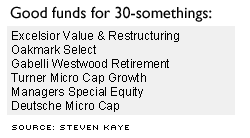 "We don't really have an investing philosophy, but we want to see if we're on the right track," Bazonski said recently. "A lot depends on whether we can have kids." "We don't really have an investing philosophy, but we want to see if we're on the right track," Bazonski said recently. "A lot depends on whether we can have kids."
The couple live in a quaint New England town outside of New Haven in a house they bought in 1999 for $220,000. They have a 30-year mortgage of $170,000 at a fixed rate of 6.75 percent. They also have term life insurance coverage of $200,000 each.
Bazonski earns $42,000 a year as a trust administrator, while her husband, Joseph, 33, is a medical technologist at a hospital earning $48,000 annually. He's an avid golfer, while she likes to downhill ski. They've been trying to have a baby for about 18 months.
 Portfolio Rx is a CNNfn.com feature that looks at issues like portfolio diversification and asset allocation. In each article, we review a reader's investments and ask financial experts for advice. If you want help with your nest egg, see below for information. Portfolio Rx is a CNNfn.com feature that looks at issues like portfolio diversification and asset allocation. In each article, we review a reader's investments and ask financial experts for advice. If you want help with your nest egg, see below for information.
They have 25 stocks and 18 mutual funds spread between a joint investing account, two Rollover IRAs, a traditional IRA and a Roth IRA, two 401(k)s and a 403(b). Both Susan and Joe also have individual investing accounts. Many of the balances have lost value in the recent downturn, some as much as half.
"We would love to have two kids," Bazonski said. "If we don't have children all of this money can go towards us and our nieces and nephews."
The downturn doesn't scare the couple – Susan Bazonski realizes they're young enough to take on more risk and they've picked more growth-oriented investments. But she does wonder if she has the right diversification.
As far as retirement at 55, the details are still hazy, depending on whether they have kids.
Spreading your bets too much?
Financial planners who reviewed their portfolios and financial situation say the couple has created "by accident or design" a portfolio that mirrors the S&P 500. But on closer inspection, there is room for consolidation and improvement.
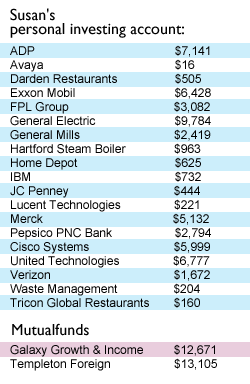 "Each account is out of whack, but added all together they do make sense," said Steven Kaye, a certified financial planner from Watchung, N.J. "They have so many investments scattered all over the place." "Each account is out of whack, but added all together they do make sense," said Steven Kaye, a certified financial planner from Watchung, N.J. "They have so many investments scattered all over the place."
For example, the couple's overall portfolio has a price-earnings ratio (P/E) of 30, which is about the same for the S&P 500, Kaye said. The P/E is the stock price divided by the earnings-per-share.
Still, out of the 29 stocks and 16 funds that they own, three funds represent less than 1/3 of 1 percent of the overall portfolio, Kaye said. Eight of the stocks have a value of less than $550, and the positions are so small it makes them statistically insignificant to the portfolio, he said.
Mark Groesbeck, a certified financial planner from Houston, said the couple could merge old accounts so they each have one IRA. They also might want to add some large value, small growth and small value. The overall portfolio is 42 percent large growth and 1 percent small cap, he said.
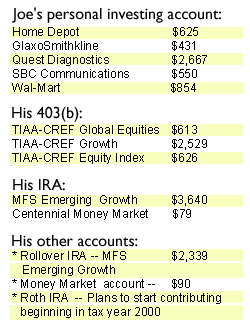 "There's a fine line between diversification and simplification," Groesbeck said. "There's a fine line between diversification and simplification," Groesbeck said.
Another option is that Joe Bazonski merge his Rollover IRA and his regular IRA, Kaye said. And Susan Bazonski could move her old 401(k) into a Rollover IRA and then combine it with her other Rollover IRA.
"When I look at the different accounts it's like looking at someone with five different personalities," Kaye said.
Kaye also found that their joint investing account was too aggressive, with a 55 percent stake in technology. The couple should put their most aggressive bets in long-term accounts and be more conservative with their joint money, he said.
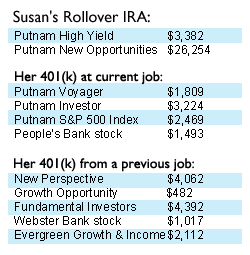 They might want to consider more fixed income for the joint account, Kaye said. That could be useful if Susan Bazonski decides to stop working after having a baby and they need more income to live on. They might want to consider more fixed income for the joint account, Kaye said. That could be useful if Susan Bazonski decides to stop working after having a baby and they need more income to live on.
Another problem is the choice of funds, Groesbeck said. For example, MFS Emerging Growth is in three different accounts. The fund has had some good years, but has slipped to the 90th percentile over 1, 3 and 5 years. That means it's falling short of 90 percent of its peers.
Likewise, Evergreen Growth & Income is in the 75th percentile over 1, 3 and 5 years. Putnam High Yield is also lagging more than half its peers, ranked in the 65th percentile over 1 year, 76th percentile over 3 years and 68th over 5 years. (Click here to check your mutual funds on CNNfn.com).
Financial planners recommend investors look for funds that are in the top 20 percent of their category over the long term, as well as low expenses.
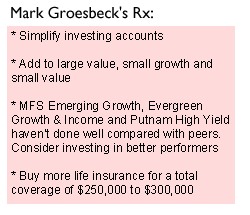 Since Groesbeck recommends the couple look beyond large growth funds like MFS Emerging Growth, they might want to pick a small cap fund with that cash, he said. Since Groesbeck recommends the couple look beyond large growth funds like MFS Emerging Growth, they might want to pick a small cap fund with that cash, he said.
Kaye agrees about the idea for more value, and recommends aggressive value funds like Excelsior Value & Restructuring and Oakmark Select. A core value fund might be Gabelli Westwood Retirement.
In the small cap universe, Kaye likes the aggressive Turner Micro Cap or moderately aggressive Deutsche Micro Cap. Managers Special Equity is a good conservative small cap option, he said.
Planning for the unknown
While a baby will obviously throw a monkey wrench into the equation, even without a family, Kaye thinks the couple will need to save more. At their current savings rate, they'll have $1.1 million in 21 years, or $47,129 in after-tax income. But that $47,129 will have the buying power of only $24,596 by then because of cost of living increases.
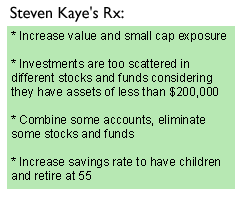
Since their retirement plans are up in the air pending a visit from the stork, it's hard to nail down exactly how much they'll need in retirement. If they do have children, there will be new braces, school books and college savings plans. It's not clear whether Susan Bazonski will stay home for a few years, which could present another retirement savings challenge.
"I think overall they're doing pretty well for their ages," Groesbeck said. "They've accumulated a nice amount for people in their 30s."
If you would like to be considered for our Portfolio Rx feature, send an e-mail to retirement@cnnfn.com with the following information: Your age, occupation, income, assets, debt and expenses, your retirement goals, such as when you wish to retire and what type of lifestyle you envision. Also include specifics about your long-term savings portfolio: your 401(k) and IRA accounts; which mutual funds, stocks and other securities you own; and information about any other source of retirement income you expect, such as a pension. Please include a daytime phone number so that we may reach you. If we choose your portfolio, we will use your information, including your name, in an upcoming story. 
* Disclaimer
|
|
|
|
|
 |

|

